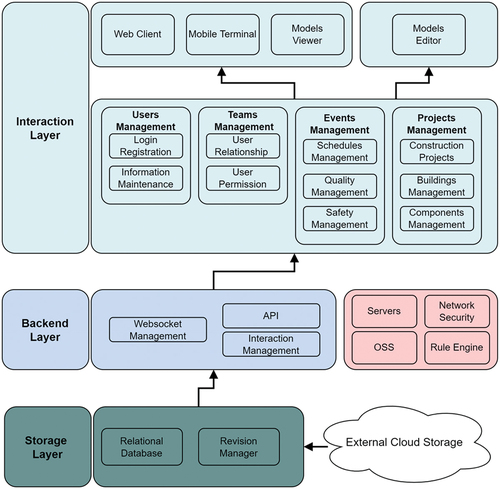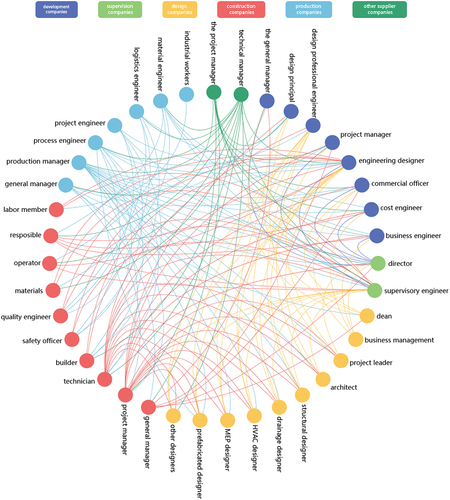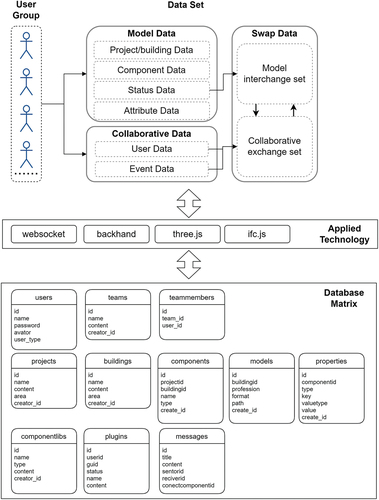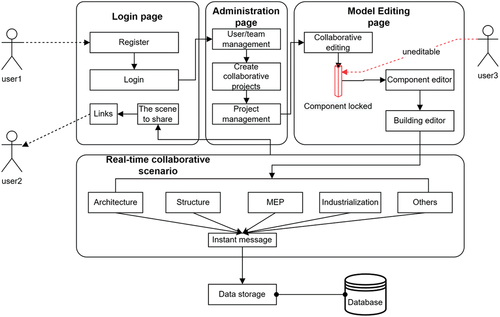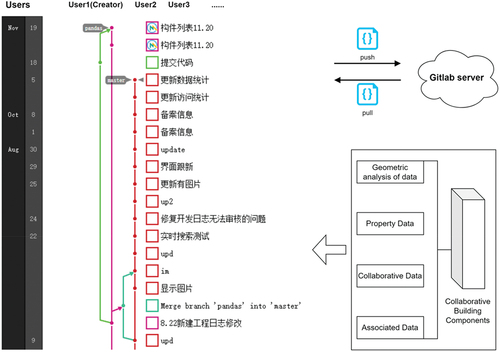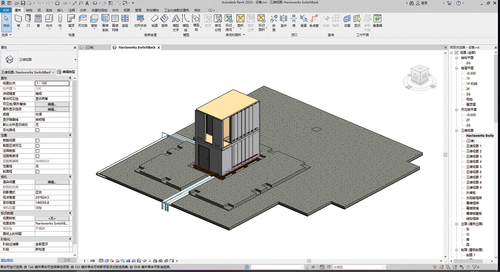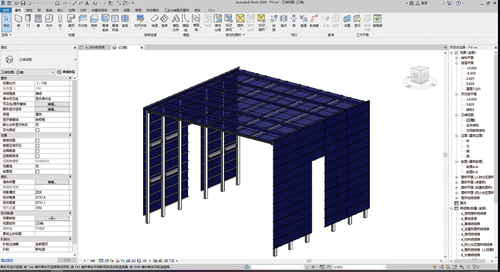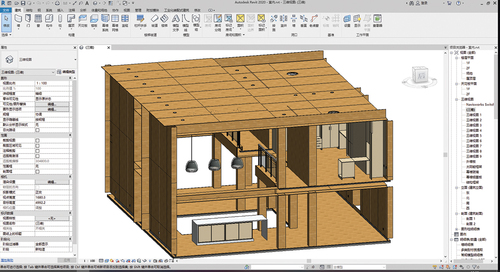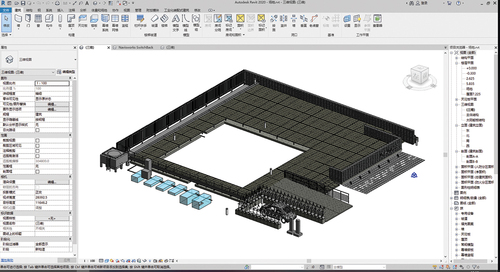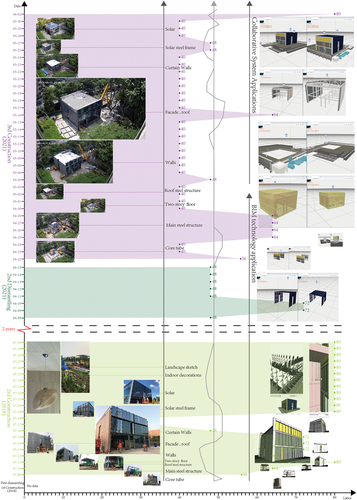ABSTRACT
This study aims to address the challenges associated with information exchange during the design and construction phases of prefabricated buildings. To overcome these obstacles, we developed a web-based Smart Collaboration System(SCS), which was inspired by Massively Multiplayer Onlinen Role-playing Game (MMORPG) technology. The methodology employed in this study involves a comprehensive literature review, the development of a prototype system, and the application of this system. The study’s results demonstrate that the utilization of MMORPG-based collaboration system improves efficiency in the design and construction process. And compared to conventional systems, the MMORPG-based system developed in this study exhibits a few key distinctions. Firstly, individual stakeholder roles are explicitly designated, enabling more efficient collaborative exchange of design and construction information. Secondly, the system effectively bridges the gap between project stages, such as design to production and production to construction. Lastly, the system introduces an element of enjoyment to the design, production, and construction process, which is typically absent in existing commercial software developers’ offerings. This research contributes to the advancement of collaborative design and construction methods by leveraging the MMORPG-based technology, and provides valuable insights for industry professionals and researchers seeking to improve collaboration and optimize the design and construction process.
1. Introduction
1.1. The current state of the industry
The construction industry has largely depended on collaborative efforts among various professional teams that come together to achieve common goals (Akintoye, Goulding, and Zawdie Citation2012). This collaboration is particularly crucial in the design and construction of prefabricated buildings, where a large number of components are fabricated in factories and then assembled on site. To effectively coordinate the diverse stakeholders involved in such projects, there is a need for an efficient Building Information Modeling (BIM) tool that can facilitate seamless collaboration between stakeholders, including designer, contractor and clients, ensuring smooth communication and coordination throughout the project lifecycle (Bakhshi et al. Citation2022). Existing BIM collaborative tools are already able to provide the conditions to address the synergy between design and construction. Liu, van Nederveen, and Hertogh (Citation2017) mentioned that BIM technology has been used as a collaborative tool in the construction field for long, changing the way designers and builders exchange information; its application has realized the preliminary collaboration between the models. Rashidi et al. (Citation2022) discussed collaborative interactive BIM-based 4D virtual reality (VR) construction planning. Typically, there are two main types of BIM-based collaborative approaches: one is that all the stakeholders collaborate through integrating models established on different platforms, and the another is that all the stakeholders collaborate on the same platform (van Berlo and Krijnen Citation2014). However, neither of these types can transfer models and interactive data in real time, where multiple users can simultaneously edit models of the same project and exchange information. Currently, it is difficult to simultaneously edit the same drawings or models, and sharing of digital files among design and constructor teams using a technology setup allows central files to network among stakeholders (Idi and Khaidzir Citation2018).
1.2. Key problems
Currently, The field of design and construction collaboration faces three key challenges: (1) there is a need to foster effective collaboration among all stakeholders across various phases of a building project; (2) Achieving efficient and user-friendly BIM-based collaboration is essential; (3) it is crucial to ensure that collaboration tools can genuinely enhance the collaborative experience for stakeholders, adding an element of enjoyment to the process. Chen and Hou (Citation2014) introduced an asynchronous online collaboration software to realize the sub-model editing collaboration, and editing the data of different sub-models by different users. These collaborative design approaches have demonstrated improvements in efficiency, particularly in the design phase. However, they often fail to extend their benefits to the construction phase of collaboration. Moreover, a large number of sub-models can significantly increase the workload for designers, without necessarily enhancing the overall collaborative experience or increasing interest of collaboration among stakeholders.
1.3. Solution
To address the challenges in design and construction collaboration, we found that leveraging the concept of massively multiplayer online role-playing game (MMORPG) could offer a promising solution. By applying MMORPG principles to the realm of prefabricated building design collaboration and construction simulation, multiple players can engage in online collaboration simultaneously. This platform enables efficient exchange, storage and inheritance of the data among all stakeholders, facilitating real-time synchronous collaboration and asynchronous collaboration. Additionally, it also adds an enjoyable aspect to the collaborative process. This paper is based on the MMORPG technology framework to develop a web-based design and construction collaboration without local installation. It aimed to facilitate collaboration between design and construction in the same context. It sought to ensure a seamless integration of the design model throughout the construction process, with the ultimate goal of achieving “one model to the end” approach. This approach enables the use of models created in the pre-design phase in all subsequent phases of the building’s life cycle). Furthermore, it allows multiple users to effortlessly interact with models and data in real time on the web while designing and constructing prefabricated buildings.
2. Literature review
Many researchers have extensively investigate collaborative design and construction, providing various technical tools and methods. However, these endeavors have often lacked the engaging appeal and interactivity found in MMOPRG games, which allow multiple participants to collaborate effectively on shared web-based platform. Despite the existing literature focusing on two collaborative technology approaches and collaboration in prefabricated buildings, there is still room for improvement in terms of engaging solutions.
2.1. Collaboration based on model format
Models created by modeling software are difficult to view or edit collaboratively by multiple users at the same time, so third-party software is needed to implement collaborative functions. Durdyev et al. (Citation2022) highlighted the challenges associated with collaborating models across different phases due to the limitations of the software itself and the file formats used for collaboration. And the only way to achieve collaboration across phases is by converting model formats, which introduces additional obstacles to the process. Ha, Jin, and Lee (Citation2015) introduced a web-based 3D model editing tool, which aimed to enhance the ease of model collaboration by using web-based platforms. However, despite this improvement, the collaboration process still relied on saving the models in a certain file format.Gui et al. (Citation2019) introduced a basic design collaboration method based on Industry Foundation Classes(IFC) format, which divides the IFC model into several parts, allowing collaborators to independently edit these models and then merge the edited models together to create a comprehensive and unified design. Singh, Gu, and Wang (Citation2011) used their own developed EDMmodelServer system to import or export IFC and BCF models by creating collaborative models on the server. Lonauer et al. (Citation2021) introduced their own web-based mechanical design collaboration software called DisMoSim, which is to achieve multi-level collaboration among different users in the domain of mechanical design and dynamics simulation. However, it should be noted that the collaborative model file format is STL, which lacks information pertaining to design and construction. This limitation implies that the software may not provide comprehensive support for the design and construction aspects of the project. Lee and Jeong (Citation2012) illustrated that the collaborative presentation of architectural models can be achieved by exchanging formats such as STEP, CIS/2, and IFC. Collaboration in this context is facilitated by using the model format as a means of communication and interaction.
2.2. Data-centric and metadata-based collaboration
In this type of collaboration, the model and information are first digitized and stored in a database, and then the collaboration is realized through software. Pauwels, Zhang, and Lee (Citation2017) mentioned that the data-centric collaboration can be conducted in two ways: one is to share files, which are stored on the Network Area Storage(NAS) for all participants to read, write, and edit; the other is to build a collaborative platform on the server. Kang and Choi (Citation2015) introduced a BIM perspective definition(BPD) data structure based on BIM metadata, dividing the metadata into style view, data view, logic view, and external data sources, which can conduct the describing and parsing of model data, providing structured data for subsequent collaboration. Some researchers have explored the implementation of real-time interactive collaboration using VR technology and BIM metadata. For example, (Du et al. Citation2018) used Unity3d game engine to enable VR-based real-time interactive collaboration. This involved linking the design process with construction simulation using VR glasses, all facilitated through a central server. Rashidi et al. (Citation2022) used BIM-based 4D VR construction planning. Khalili (Citation2021) investigated the BIM to VR data conversion to address the challenges associated with time-consuming and complex data exchange between design software and game engines. And the study applied the semantic eXtensible Markup Language (XML) as a means to achieve efficient data-centric collaboration. In a separate study, (Schiavi et al. Citation2022) developed a VR training scene editor drawing upon the expertise of BIM-4D to facilitate training for construction operators in building construction processes. This editor uses VR simulations to allow trainees to interact with and assemble building components in a virtual environment, while also extending collaboration to construction training.
2.3. Collaborative design and construction of prefabricated buildings
Collaboration in the context of prefabricated buildings involves more participants compared to traditional construction, emphasizing the need for efficient data interaction and participant engagement with numerous component models. Xu et al. (Citation2023). illustrate that real-time collaboration between designers, fabricators, and constructors faces several obstacles due to the lack of software specifically designed to support BIM for prefabricated buildings (PC-BIM). Bortolini, Formoso, and Viana (Citation2019) investigated the simulation of production, transportation, and construction processes in prefabricated buildings using BIM. They used ArchiCAD® software for modeling and Synchro Pro® software for scheduling and construction management. This approach provides a comprehensive solution for prefabricated buildings by eliminating the need to create models in one software and convert them to another for collaboration, thereby increasing efficiency and engagement. In a related study, (Wei, Choi, and Lei Citation2021). used parametric programming to introduce the concept of design for assembly and manufacturing (DfMA) modular construction for prefabricated buildings. This approach facilitates collaboration throughout all phases of prefabricated buildings by visualizing and simulating the feasibility of each phase.
3. Research objectives and questions
3.1. Research scope and objective
The objective of this research is to develop a prototype system for web-based MMORPG specifically designed for prefabricated buildings. The system aims to incorporate engaging features that promote collaboration between design and construction teams involved in prefabricated building projects. Additionally, the system should facilitate efficient exchange of model data with various design software commonly used in the industry.
3.2. Research question
The research question of this study is as follows:
How can a prototype MMORPG-based system be developed to facilitate real-time and engaging online collaboration, with high efficiency, among multiple stakeholders involved in the design and construction process of prefabricated buildings?
There are two main problems identified in the context of the design and construction process of prefabricated buildings: i) poor information sharing and communication. The collaborative nature of of prefabricated building projects necessitates effective information sharing and communication among various engineers and stakeholders. However, due to the spatial and temporal difference, there are information deviations in the working process; ii) Lack of efficiency and interesting synergy. The current collaboration methods employed in prefabricated building projects often lack efficiency and fail to provide an engaging user experience. Zhao and Taib (Citation2022) introduced a real-time collaborative platform for BIM-based on cloud computing technology, which can support multiple stakeholders to work together in real time on the same model. Therefore, the absence of effective collaboration tools is the core problem. In addition, another obstacle to the implementation of BIM is the lack of standards and tools for the prefabricated building industry Tan Citation2019 (Oraee et al. Citation2019) analyzed the multiple aspects of collaboration barriers in the BIM construction process, identifying the reasons for the inability of BIM to achieve collaboration, which inspired the current research. Potseluyko et al. (Citation2022) examined a BIM-based model for VR interaction in games-like interactive environment. This model offers engaging experience and serves as a valuable reference for collaborative design and construction inspired by MMORPGs. However, the model currently only supports individual operation and does not facilitate multiplayer collaboration.
4. Results
The research yield the development of a web-based MMORPG prototype system known as the Smart Collaboration System (SCS). This system supports the import of models from various design software and enables real-time online collaborative design and construction of prefabricated buildings. The SCS system provides an engaging user experience, allowing stakeholders to experience collaboration that is reminiscent of playing a game.
4.1. SCS technical architecture
SCS is a web-based application with VUE as the front-end framework, Laraval as the back-end framework for data processing, MySQL relational database, socket.io library for the communication interface, Typescript as the development language, and Python on the back-end for modeling tools. The software framework was examined under this implementation to enable collaboration.
The SCS technical architecture contains three main layers (): i) the interaction layer, which implements various functions for users to interact; ii) the back-end layer, which provides data interfaces to the front-end and communicates with the database; iii) the storage layer, which includes a relational database and cloud storage for storing data and metadata.
The interaction layer contains three pages: i) the client page, for web and mobile and model viewing; ii) the model editing page, for editing the model; iii) the management page, for user, team, event and project management, and specific management. The back-end layer includes two parts: one is for websocket management interface, Application Programming Interface (API) for communication with database, the other is for some functions to support back-end services, such as server management, network security, Object Storage Service (OSS) and rule methods. The storage layer primarily consists of a relational database and version management system. It has the capability to incorporate additional metadata, and can be supplemented with cloud storage as well.
Based on this architecture, the basic front-end interactive interface for real-time collaboration of prefabricated building was established. Different from MMORPG, SCS involves multiple project types, with limited interconnection between them.
The SCS enables collaboration throughout the entire process of design and construction of prefabricated building by using BIM models, thereby enhancing the engagement of stakeholders. In addition to analyzing files, information, and metadata, the system allows for active participation in the project, making the implementation process more engaging. The following 6 feature functions are also included: i) Realizing the collaboration of the same model in design and construction of the project; ii) Realizing the collaboration of different organizations of different stakeholders in the same model scene, and being able to enter and exit at any time; iii) Improving the efficiency of prefabricated building collaboration by using components as the basic collaboration unit. iv) Realizing the collaboration of building construction through MMORPG-based and web-based. v) Realizing real-time and historical collaboration, recording all collaborative data and ensuring traceability.
In addition to developing the SCS, our research also focused on collaborative processes and data architecture.
4.2. Stakeholder relationships
In contrast to MMORPGs, collaboration in building projects involves a diverse range of stakeholder types and intricate relationships. Thus, understanding these relationships is crucial. The study primarily focused on implementing collaboration relationships among stakeholders during the design and construction phases of the project. Nguyen, London, and Zhang (Citation2021) conducted a literature review that specifically examined off-site construction stakeholders, with a particular emphasis on collaboration, BIM, social network analysis, and supply chain. The review highlighted the importance of collaboration and BIM for stakeholders involved in the construction industry. Yuan et al. (Citation2021) studied the key risks and stakeholder interactions throughout the whole life cycle of a project’s social network. The study identified 41 nodes connected by 232 directed links, including various entities such as government agencies, users, construction companies, design companies, manufacturing companies, supervision entities, and property management companies. To facilitate collaboration in design and construction and fulfill project requirements, our study identified six types of companies: development companies, supervision entities, design firms, construction companies, production companies, and other suppliers. We analyzed the relationships among various functional departments and project stakeholders involved in a project and integrated them into the collaboration system to develop systematic management and accumulate data ().
4.3. Data structure
To facilitate collaboration, we identified a set of 11 tables, including users, teams, team members, projects, buildings, components, componentlibs, models, properties, plugins, and messages tables ().The relationships between user groups, collaborative related data sets, applied to technologies and database matrices are detailed in
Table 1. SCS database tables.
4.4. Collaboration architecture and versions
4.4.1. Collaboration architecture
Using the aformentioned database structure, we formulated the comprehensive collaborative operation process of the stakeholders within the SCS. For detailed information on the specific operation process, see .
Users who are not registered need to register, then log in the system to manage their teams, creating teams, companies. After completing team building, user can create a collaborative project, including two types of information: i), basic project information; ii), building information; after the project is created, users can edit or share the project, and decentralize the management of different participants in the project. The basic unit of decentralization means that when a user edits a component, the rights of editing components are locked, and other users cannot operate it. After editing the component is finished and stored in the database. For example, when the construction design manager supervises the design process and marks out the issues found in the model, the information can be displayed in real-time or sent to the corresponding designers after reviewing. As for the production company, the process engineer evaluates the design results, gives feedback and notifies the developer, and then sends the design results back to the design company after confirmation. The realization of the whole collaborative process is realized through the mutual exchange of information among the stakeholders.
It is essential to conduct a thorough analysis of stakeholder requirements and integrate them into a collaborative framework, based on which the simulation needs of the prefabricated building in the design and construction process would be solved.
4.4.2. Collaborative version control
MMORPG has the function of storing data, but it does not have the function of version management for each component. Most MMORPG are linear, which is different from the prefabricated building complex construction process (Gosselin et al. Citation2018). In the building construction process, since the interaction between the stakeholders leads to changes in the version of the model itself, the inconsistency of the current model drawings would occur. Cristie and ConradJoyce (Cristie and Joyce Citation2021) developed a GHshot plug-in in the Grasshopper parametric design tool in Rhino to achieve the similar code versioning, which enables the versioning of GH-created models. To effectively manage versions in SCS, it is crucial to maintain detailed data records. Collaborative models serve as the primary management objects, and users have different roles when accessing the SCS platform. Therefore, we need to record the changes in data before and after users edit the model, and convert the model data into text data that can be managed by versioning. We use git to push, pull, and merge the model data, so that the version of the collaboration data can be managed , as shown in . This versioning approach is similar to the structural tree model versioning approach adopted by (Chen and Hou Citation2014).
5. Case studies
5.1. Project case introduction
The Solar Decathlon China (SDC) 2018 entry “C-House” is a 20-day building built by Southeast University and Technical University of Braunschweig.It used the theory and technology of component-based architectural design, ultra-high-speed construction technology, graded assembly technology, and BIPV integration technology, as shown in .
The project has undergone two demolition and construction processes since the competition in 2018, followed by one demolition and another reconstruction in 2021 at the Sipailou Campus of Southeast University in Nanjing, Jiangsu Province, in which a whole life-cycle collaborative design, construction, demolition, and re-build process is carried out, in which collaborative design technologies and SCS is applied.
5.2. Model preparation
The project underwent a four-year experimental process that involved using Autodesk Revit modeling (refer to ) and project management through BIM. The model served as the foundation for system application during the second demolition and the subsequent third construction process. The model was displayed and collaboratively managed on a web platform. Initially, the model data was processed and outputted in IFC format before being imported to the collaborative platform. The project involved the collaboration of 24 individuals and stakeholders from design and construction companies. However, the involvement of component production companies was not considered during the third construction process. Some components were damaged during the dismantling phase and required repair, which was subsequently carried out by the construction company.
To complete the task of dismantling and reassembling the project, the project was planned in detail through the SCS. The plan included a thorough simulation of the dismantling process, transportation plan, and reassembling plan for each component. All project stakeholders involved in the project collaboratively processed the data using the model processing function of SCS to ensure that the plan was carefully reviewed, validated and optimized for feasibility and effectiveness.
5.3. Collaborative process
provides a comprehensive depiction of the design and construction process of the c-house, highlighting the use of the SCS during the second demolition and third construction phase. This phase is comprised of 3 key steps:
5.3.1. Collaboration of project component dismantling process
This process is done by uploading the model to SCS, first simulating the demolition process through the model, grouping the components, numbering them after completion, and then assigning them to designers and component installers through the components that have been numbered, and solving some details that were not considered due to the demolition process through the simulation of component removal and assembly.
5.3.2. Collaboration of dismantling, transportation, and assembly simulation
Following the numbering of each component, a simulation is conducted to plan for the demolition, transportation, and assembly of the structure. Different users are assigned specific access rights to effectively record and manage data throughout the process. This data is subsequently used to develop a comprehensive simulation plan that anticipates potential issues and ensures a smooth demolition, transportation, and assembly process.
5.3.3. Collaboration of formal demolition, transportation, and assembly
Formal demolition, transportation and assembly are executed collaboratively using a simulation scene. Data is collected through platform tools and correlated with backend models to compare simulated scenes with the actual implementation processes. Quantitative data such as time and man-days are measured and compared to optimize the functionality of the SCS.
5.4. Collaborative efficiency assessment
The collaborative efficiency was compared in two dimensions: first, construction time; second, man-days consumed in the process. The project had component production content in the first build process, and the other phases were only demolition, construction, and transportation content. The collaborative efficiency comparison did not consider the content of component production. Since the first pre-build and dismantling processes were not recorded with data and could not be compared, the focus was chosen to compare the second 2018 build process without using the SCS with the third 2021 build process after using the SCS, and the second 2021 dismantling process, although the SCS was applied, had no comparable object and therefore was not analyzed.
5.4.1. 2018 second construction
5.4.1.1. Construction time
The construction period for the competition spanned from the official start of construction on July 9 to the completion of construction on July 30, totaling 22 days. provides a breakdown of the construction time for each type of component group.
Table 2. 2nd build time in 2018.
5.4.1.2. Construction work hours
Between July 9 and July 30, a total of 194 man-hours were consumed based on labor and working hours, as detailed in .
Table 3. 2nd build construction working hours.
5.4.2. 2021 third construction
5.4.2.1 Construction time
The construction period of the third build was lengthened because there was no tight time requirement during the competition, and it was not built continuously, and the total time used was 35 days, as detailed in .
Table 4. 3rd build construction working hours.
5.4.2.2 Construction work hours
Due to the lengthening of the cycle and the reduction of construction personnel, there was 5 construction personnel on site, as detailed in , and a total of 191 man-hours were consumed after statistics.
Table 5. 3rd build time in 2021.
shows a comparison of the man-hours consumed, indicating a slight decrease, although the decrease is not deemed significant.
Table 6. Comparison of construction time and man-hours consumed.
Through comparison, it can be found that the overall collaborative efficiency is improved with the help of the SCS. Although the process of collaborative simulation or construction by multiple users in the same scene model was realized, the efficiency was improved and the data of the construction process was recorded by the system, which is a prototype system and some of the work needs to be done manually. As the system adopts MMORPG architecture, the users involved in the collaboration praise the high interest in the collaboration process.
6. Discussion
This study proposes a collaborative approach inspired by MMORPG to address the need for real-time collaborative simulation in the design and construction process of prefabricated buildings. A prototype collaborative system(SCS) was established using a web-based multi-user platform. The SCS was implemented and evaluated in the third reconstruction phase of C-house project. The construction process data of this project was analyzed and compared to the efficiency of two similar stages – one without the SCS and one with the SCS – to assess the impact and effectiveness of the system.
In the system, the initial design phase involves exporting IFC files from Autodesk Revit and importing them into the SCS for component processing. After the component processing, the model is divided into smaller collaborative units, which are then assigned to designated designers or construction teams. Different users can access different model states, and through version management of model data, they can facilitate the iterative collaboration of model operations.
The simulation of the dismantling process within the system includes the simulation of transportation and construction of the dismantled components, which enables multiple users to simulate the construction and transportation of the same project in the same model scene. However, it is important to note that the system has a limitation in that it does not integrate with the production process of the project. The production process of components requires more rigorous manufacturing considerations, and the simulation and production management capabilities of the system alone may not fully meet the needs of manufacturing production.
To overcome this limitation, we propose limiting the extent of collaboration during the component production stage and focusing on the key aspects to provide the essential collaborative data for the production stage, while offering data support for other stages. Production units typically employ their own Manufacturing Execution System (MES), and integrating the collaboration system with the construction process can be achieved through open APIs and defining the data transfer protocols and formats. This will be the focus of our subsequent research, aiming to achieve comprehensive life cycle management of prefabricated buildings, using the MMORPG-based SCS.
7. Summary and outlook
The objective of this study is to address the challenges associated with information exchange in the design and construction phases of prefabricated building. This is achieved by developing a web-based collaborative software (SCS), utilizing MMORPG elements to enhance the engagement of the collaboration process. The efficiency of the SCS is evaluated through its implementation in the C-House construction process. The SCS prototype system tackles the collaboration needs of various stakeholders by providing a unified platform for collaboration. Through a comparative analysis of the efficiency between the second and third construction stages of C-House project, the system has demonstrated its capability to reduce man-hours and improve the efficiency of BIM-based collaboration. Furthermore, the introduction of the MMORPG model brings an element of engagement into the collaboration process, providing a research foundation for achieving a engaging collaborative experience in the realm of prefabricated buildings.
However, the study has certain limitations and areas that can be further improved. Firstly, the modeling functions could benefit from enhancements, such as establishing a library of different components based on component design logic, which would facilitate the creation of collaborative component models. Secondly, the handling capability of emergent issues is currently insufficient. Implementing an early warning method of emergent issues becomes crucial to detect and address potential issues in advance through the analysis of the model. Thirdly, the system currently lacks support for a large number of users. To address this, optimization of the model expression and database structure is needed to enhance the system’s capacity to handle a larger user base.
In conclusion, the implementation of an efficient collaboration system is crucial in the realm of prefabricated buildings. This study introduces the SCS, a collaboration software based on MMORPG, which effectively addresses the challenges associated with information exchange and enhances the i engagement of the collaboration process. The findings of this research provides a foundation for achieving a engaging collaborative experience in construction industrialization through prefabricated buildings. Furthermore, the study offers directions and suggestions for future research endeavors, highlighting the need for continuous improvement and optimization of the system to meet the needs of the industry.
Disclosure statement
No potential conflict of interest was reported by the author(s).
Additional information
Funding
Notes on contributors
Hongyu Ye
Hongyu Ye is presently a Ph.D. candidate in the School of Architecture at Southeast University, Nanjing, China. He graduated with a master’s degree from Southeast University. He used to undertake prefabricated building design and design software development in enterprises, and has rich experience in engineering design, construction and technology development. He is now studying for his Ph.D. studies at the School of Architecture, Southeast University, focusing on building industrialization, collaborative design and intelligent construction.
Hong Zhang
Hong Zhang Professor, a distinguished scholar with a doctoral degree in engineering, currently holds the positions of Director, Professor, and Doctoral Tutor at the Institute of Architectural Technology, School of Architecture, Southeast University. Additionally, he is a nationally recognized first-class registered architect and serves as the Director of the Institute of Industrialized Housing and Construction Industry at Southeast University. Professor Zhang’s expertise lies in scientific research and teaching, encompassing architectural design and construction, the theory and practice of construction industrialization, application of Building Information Model (BIM), as well as research and development in residential studies and residential design.
Qiong Chen
Qiong Chen is currently working at Jinling Institute of Technology. She received the B.S. degree in Xi’an Jiaotong University, Xi’an, in 2009 , the M.S. degree in School of Architecture, Southeast University, Nanjing, in 2012 and the Ph.D. degree in Southeast University ,in 2023. Her research interests include architectural design, transportation environment, etc. She has published 4 SCI papers.
Bo Sun
Bo Sun obtained a bachelor’s degree in environmental art from Shandong Agricultural University in 2015 and a master’s degree in art and design from China University of Mining and Technology in 2018. Since 2021, he has been pursuing his Ph.D. at Southeast University. His research interests include building information modeling, urban microclimate, and landscape design.
Bo Wen
Bo Wen Associate Professor, School of Architecture, Sanjiang College,he is currently pursuing his Ph.D. at the School of Civil Engineering, Nanjing Tech University, mainly engaged in the construction of the course group in the direction of architectural technology and the teaching of related courses, presided over a number of teaching reform and teaching research projects. For many years, she has instructed students to participate in the National Higher Education Institutions Green Building Design Skills Competition and won awards. She has won many teaching and research honors and awards.
References
- Akintoye, A., J. Goulding, and G. Zawdie. Eds. 2012. Construction Innovation and Process Improvement. Chichester, West Sussex, U.K. ; Ames, Iowa: Wiley-Blackwell.
- Bakhshi, S., M. R. Chenaghlou, F. Pour Rahimian, D. J. Edwards, and N. Dawood. 2022. “Integrated BIM and DfMA Parametric and Algorithmic Design Based Collaboration for Supporting Client Engagement within Offsite Construction.” Automation in Construction 133 : 104015. https://doi.org/10.1016/j.autcon.2021.104015.
- Tan, T., K. Chen, F. Xue, W. Lu.2019. “Barriers to Building Information Modeling (BIM) Implementation in China’s Prefabricated Construction: An Interpretive Structural Modeling (ISM) Approach.” Journal of Cleaner Production 219: 949–959. https://doi.org/10.1016/j.jclepro.2019.02.141
- Bortolini, R., C. T. Formoso, and D. D. Viana. 2019. “Site Logistics Planning and Control for Engineer-To-Order Prefabricated Building Systems Using BIM 4D Modeling.” Automation in Construction 98:248–264. https://doi.org/10.1016/j.autcon.2018.11.031.
- Chen, H. M., and C. C. Hou. 2014. “Asynchronous Online Collaboration in BIM Generation Using Hybrid Client-Server and P2P Network.” Automation in Construction 45:72–85. https://doi.org/10.1016/j.autcon.2014.05.007.
- Cristie, V., and S. C. Joyce. 2021. “Versioning for Parametric Design Exploration Process.” Automation in Construction 129 (April): 103802. https://doi.org/10.1016/j.autcon.2021.103802.
- Du, J., Z. Zou, Y. Shi, and D. Zhao. 2018. “Zero Latency: Real-Time Synchronization of BIM Data in Virtual Reality for Collaborative Decision-Making.” Automation in Construction 85:51–64. https://doi.org/10.1016/J.AUTCON.2017.10.009.
- Durdyev, S., M. Ashour, S. Connelly, and A. Mahdiyar. 2022. “Barriers to the Implementation of Building Information Modelling (BIM) for Facility Management.” Journal of Building Engineering 46:103736. https://doi.org/10.1016/J.JOBE.2021.103736.
- Gosselin, A., P. Blanchet, N. Lehoux, and Y. Cimon. 2018. “Collaboration Enables Innovative Timber Structure Adoption in Construction.” Buildings 8 (12): 183. https://doi.org/10.3390/buildings8120183.
- Gui, N., C. Wang, Z. Qiu, W. Gui, and G. Deconinck. 2019. “IFC-Based Partial Data Model Retrieval for Distributed Collaborative Design.” Journal of Computing in Civil Engineering 33 (3): 04019016. https://doi.org/10.1061/(asce)cp.1943-5487.0000829.
- Ha, Y. U., J. H. Jin, and M. J. Lee. 2015. “Lets3D: A Collaborative 3D Editing Tool Based on Cloud Storage.” International Journal of Multimedia and Ubiquitous Engineering 10 (9): 189–198. https://doi.org/10.14257/ijmue.2015.10.9.20.
- Idi, D. B., and K. A. M. Khaidzir. 2018. “Critical Perspective of Design Collaboration: A Review.” Frontiers of Architectural Research 7 (4): 544–560. https://doi.org/10.1016/j.foar.2018.10.002.
- Kang, T. W., and H. S. Choi. 2015. “BIM Perspective Definition Metadata for Interworking Facility Management Data.” Advanced Engineering Informatics 29 (4): 958–970. https://doi.org/10.1016/J.AEI.2015.09.004.
- Khalili, A. 2021. “An XML-Based Approach for Geo-Semantic Data Exchange from BIM to VR Applications.” Automation in Construction 121:103425. https://doi.org/10.1016/J.AUTCON.2020.103425.
- Lee, J., and Y. Jeong. 2012. “User-Centric Knowledge Representations Based on Ontology for AEC Design Collaboration.” CAD Computer Aided Design 44 (8): 735–748. https://doi.org/10.1016/j.cad.2012.03.011.
- Liu, Y., S. van Nederveen, and M. Hertogh. 2017. “Understanding Effects of BIM on Collaborative Design and construction An Empirical Study in China.” International Journal of Project Management 35 (4): 686–698. https://doi.org/10.1016/j.ijproman.2016.06.007.
- Lonauer, P., D. Holzmann, C. Leitner, A. Probst, S. Pöchhacker, S. Oberpeilsteiner and J. Schönböck. 2021. “A Multi-Layer Architecture for Near Real-Time Collaboration During Distributed Modeling and Simulation of Cyberphysical Systems.” Procedia Computer Science 180:190–199. https://doi.org/10.1016/j.procs.2021.01.156.
- Nguyen, B. N., K. London, and P. Zhang. 2021. “Stakeholder Relationships in Off-Site Construction: A Systematic Literature Review.” Smart and Sustainable Built Environment 11 (3): 765–791. https://doi.org/10.1108/SASBE-11-2020-0169.
- Oraee, M., M. R. Hosseini, D. J. Edwards, H. Li, E. Papadonikolaki, and D. Cao. 2019. “Collaboration Barriers in BIM-Based Construction Networks: A Conceptual Model.” International Journal of Project Management 37 (6): 839–854. https://doi.org/10.1016/j.ijproman.2019.05.004.
- Pauwels, P., S. Zhang, and Y. C. Lee. 2017. “Semantic Web Technologies in AEC Industry: A Literature Overview.” Automation in Construction 73:145–165. https://doi.org/10.1016/j.autcon.2016.10.003.
- Potseluyko, L., F. Pour Rahimian, N. Dawood, F. Elghaish, and A. Hajirasouli. 2022. “Game-like interactive environment using BIM-based virtual reality for the timber frame self-build housing sector.” Automation in Construction 142:104496. https://doi.org/10.1016/j.autcon.2022.104496.
- Rashidi, A., W. Y. Yong, D. Maxwell, and Y. Fang. 2022. “Construction Planning Through 4D BIM-Based Virtual Reality for Light Steel Framing Building Projects.” Smart and Sustainable Built Environment 12 (5): 1153–1173. https://doi.org/10.1108/SASBE-06-2022-0127.
- Schiavi, B., V. Havard, K. Beddiar, and D. Baudry. 2022. “A VR Training Scenario Editor for Operation in Construction Based on BIM 4D and Domain Expert Authoring.” Smart and Sustainable Built Environment 12 (5): 1074–1089. https://doi.org/10.1108/SASBE-06-2022-0125.
- Singh, V., N. Gu, and X. Wang. 2011. “A Theoretical Framework of a BIM-Based Multi-Disciplinary Collaboration Platform.” Automation in Construction 20 (2): 134–144. https://doi.org/10.1016/j.autcon.2010.09.011.
- van Berlo, L., and T. Krijnen. 2014. “Using the BIM Collaboration Format in a Server Based Workflow.” Procedia Environmental Sciences 22:325–332. https://doi.org/10.1016/j.proenv.2014.11.031.
- Wei, Y., H. Choi, and Z. Lei. 2021. “A Generative Design Approach for Modular Construction in Congested Urban Areas.” Smart and Sustainable Built Environment 11 (4): 1163–1181. https://doi.org/10.1108/SASBE-04-2021-0068.
- Xu, H., R. Chang, N. Dong, J. Zuo, and R. J. Webber. 2023. “Interaction Mechanism of BIM Application Barriers in Prefabricated Construction and Driving Strategies from stakeholders’ Perspectives.” Ain Shams Engineering Journal 14 (1): 101821. https://doi.org/10.1016/j.asej.2022.101821.
- Yuan, M., Z. Li, X. Li, and X. Luo. 2021. “Managing Stakeholder-Associated Risks and Their Interactions in the Life Cycle of Prefabricated Building Projects: A Social Network Analysis Approach.” Journal of Cleaner Production 323: 129102. https://doi.org/10.1016/j.jclepro.2021.129102.
- Zhao, Y., and N. Taib. 2022. “Cloud-Based Building Information Modelling (Cloud-BIM): Systematic Literature Review and Bibliometric-Qualitative Analysis.” Automation in Construction 142:104468. https://doi.org/10.1016/j.autcon.2022.104468.

